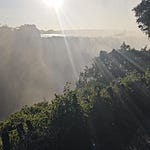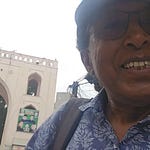MI’s "five minutes of fame" comes to you from Colombo, Sri Lanka… a very hot and humid day, but am in my elements and enjoying it. This is a nation that once bore the scars of a protracted civil war, yet has since transitioned into a relatively stable democracy with functioning institutions and tangible socio-economic development. From this vantage point, I find myself reflecting on two troubling issues recently encountered in Somalia—problems that reflect deeper systemic fractures and enduring institutional fragility (See the attached video).
With the monsoon heat and humidity painting a glistening sheen—yes, that's sweat, not a special effect—across my face, I bring you these unedited clips, raw and real. For the Somali-language version of this post, kindly click the link below. And if the AI translation falls short of your literary expectations, do forgive its digital limitations
https://ayuub.org/soomaaliya-ma-wajahaysaa-dagaal-weligeed-soconaya/.
The ongoing conflict in Somalia is not merely a confrontation between government forces and militant insurgents; it is a manifestation of deeper systemic failures—moral, religious, and political. A striking dimension of this tragedy is the instrumentalization of religion by the Al-Shabaab terrorist group. Cloaked in the rhetoric of Islam, the group’s interpretation of religious doctrine is not only intellectually vacuous but doctrinally bankrupt. These individuals, many of whom lack even basic theological education, reduce the rich spiritual and jurisprudential traditions of Islam into simplistic, violent dogma. Their actions betray the very principles they claim to uphold replacing them with brutality, coercion, and fear.
This theological illiteracy is not accidental. Rather, it is exploited by a cadre of external financiers and ideological entrepreneurs, greedy, self-serving actors who have no stake in Somalia's future beyond its utility as a strategic pawn. These funders, both regional and international, benefit from Somalia’s continued instability. They arm and sustain Al-Shabaab not out of religious solidarity, but because chaos serves their political or economic interests. For them, an ungovernable Somalia is a useful vacuum, a zone of impunity for illicit trade, proxy warfare, and geostrategic leverage.
Equally disheartening is the conduct of certain Somali parliamentarians, many of whom ascend to their positions not through merit or national vision, but via narrow clan allegiances. Selected by tribal chiefs to represent parochial interests, these MPs often act as tribal gatekeepers rather than national legislators1. When confronted with the existential threat posed by Al-Shabaab, they frequently withhold support for government soldiers on the frontlines. Their refusal to champion the fight against terrorism, sometimes driven by fear, sometimes by allegiance to clan rivalries undermines national cohesion and emboldens insurgents.
This toxic interplay between religious ignorance, foreign exploitation, and tribal fragmentation creates a vicious cycle that renders meaningful governance elusive. While Somali soldiers risk their lives to defend the republic, their efforts are often betrayed not just by the bullets of terrorists, but by the indifference or obstruction of their own selected (not elected) members of parliament. For Somalia to move toward peace and sovereignty, there must be an unflinching reckoning with these internal contradictions. The country’s salvation lies not only in defeating Al-Shabaab militarily but in dismantling the corrupt systems: ideological, financial, and tribal that allow such groups to thrive.
Reflections on two nations and an ocean of difference.
Sri Lanka and Somalia are two countries with markedly different trajectories, yet they share some common challenges. Somalia is nearly ten times larger than Sri Lanka: 637,000 square kilometers to Sri Lanka’s 65,000.
Both countries rely heavily on remittances: 35–40% of Somalia’s GDP, to about 10% of GDP. Sri Lanka has a more diversified economy, including textiles, tea, and tourism, while Somalia’s economy is largely informal, reliant on livestock, diaspora transfers, and limited service sectors like telecommunications.
Conflict has shaped both nations' modern histories. Sri Lanka endured a protracted civil war between the government and Tamil separatists from 1983 to 2009, after which it transitioned to a relatively stable democratic republic. Somalia, on the other hand, has faced continual state collapse since 1991, with ongoing violence driven by clan divisions and militant groups like Al-Shabaab.
While Sri Lanka has made significant strides in rebuilding state capacity and advancing human development indicators, Somalia remains mired in cycles of political fragmentation, foreign dependence, and conflict-induced underdevelopment. The comparison is sobering. So, cui bono? The long and short answer is the funders of the Shabab terrorist. Not the terrorists themselves, they are nothing but tools used by others.
What is striking in this moment is not merely the contrast between these two post-conflict societies, but the symbolism embedded in their geography. Somalia and Sri Lanka are separated by the Indian Ocean—a physical distance measurable in mere thousands of kilometers. Yet, the more profound divide lies in what might be called a chasm of human capacity development: institutional resilience, educational infrastructure, public health systems, and governance frameworks.
Somali MPs are not elected, but selected by their local tribal chiefs. Many years ago, we have tried to educate them via https://somsog.org/ … this is an educational website that I and Steve Liddle, a researcher/writer based in NZ developed many years ago, and would like to recommend it. The main idea behind the online Somali School of Government is to give the Somali leaders, parliamentarians and all those who are involved in government businesses and the state bureaucracy, the opportunity to extend their knowledge in civics and the modern mechanics of government in the 21st century.













Share this post